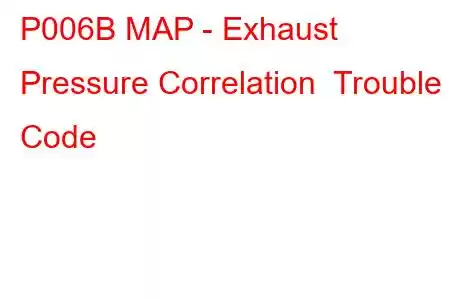P006B MAP - Exhaust Pressure Correlation
OBD-II Trouble Code Technical Description
MAP - Exhaust Pressure Correlation
What does that mean?
This generic powertrain diagnostic trouble code (DTC) typically applies to many OBD-II vehicles. That may include but is not limited to vehicles from Ford, GMC, Chevrolet, Dodge, etc., however it seems to be most common on Ford Powerstroke Diesel Trucks.
If your OBD-II vehicle has stored a code P006B, it means that the powertrain control module (PCM) has detected a discrepancy in the correlating signals between the manifold absolute pressure (MAP) sensor and the exhaust pressure sensor (EPS).
In some vehicle applications, the MAP sensor may be referred to as a barometric pressure sensor. In my professional experience, only vehicles with diesel engines utilize exhaust pressure sensors. If other MAP sensor or exhaust related codes are present, diagnose and repair those before attempting to diagnose a code P006B.
The MAP sensor measures air density (pressure) in the intake manifold in either kilopascal (kPa) units or inches of mercury (Hg). These measurements are received by the PCM as input voltage signals. If the MAP signal is substituted for a barometric pressure signal, it is still measured in similar increments. Diesel equipped vehicles utilize one or more exhaust pressure sensors to monitor exhaust back pressure. Exhaust back pressure is an excellent indicator of catalyst efficiency, diesel particulate filter efficiency, and NOx filter efficiency. Exhaust back pressure is also critical to engine performance and emission reduction in today’s clean burning diesel engines.
A code P006B will be stored, and a malfunction indicator lamp (MIL) may be illuminated, if the PCM detects voltage input signals (between the MAP sensor and the exhaust pressure sensor) which differ by more than a programmed degree over a certain period of time and under a particular set of circumstances. A reliable vehicle information source (such as AllData DIY) will yield exact parameters for code storage as it relates to the vehicle in question. In some vehicle applications, MIL illumination may require multiple drive cycles with a failure.
An example of a MAF sensor:
What is the severity of this DTC?
The two sensors related to this code are critical to engine performance and efficiency. Therefore, the P006B should be classified as severe.
What are some of the symptoms of the code?
Symptoms of a P006B engine code may include:
Abnormally excessive smoke from exhaust Excessive fuel consumption A general lack of engine performance Rich or lean exhaust conditionWhat are some of the common causes of the code?
Causes for this code may include:
Defective exhaust pressure sensor Faulty MAP sensor Open or shorted wiring or connectors PCM or PCM programming errorWhat are some P006B troubleshooting steps?
When diagnosing a code P006B, I would gain access to a diagnostic scanner, a digital volt/ohmmeter (DVOM), and a reliable vehicle information source.
Visually inspect all related wiring and connectors, paying close attention to wiring harnesses and connectors that are routed near hot exhaust components and the sharp edges associated with exhaust shields. If any damaged or burned areas are detected, make repairs as necessary.
My next step would be connecting the scanner to the vehicle diagnostic port and retrieving all stored codes and freeze frame data. I like to write this information down because it may help me later in my diagnosis. After that, I would clear the codes and test-drive the vehicle to see if the code is reset.
If the code is immediately reset, I would use the DVOM to test for reference voltage (typically 5-volts) and a ground at the MAP and exhaust pressure sensor connectors. I would simply connect the positive test lead of the
Read: 52


